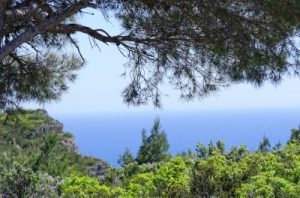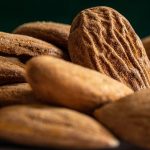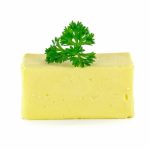Pycnogenol® has been researched as a supplement to be taken in lowering blood pressure, improving the cardiovascular system generally, reducing atherogenesis and blood clots (thrombus) and also ameliorating the effects of diabetic retinopathy. There are numerous studies illustrating pycnogenol benefits and has been excellently reviewed (Maimoona et al., 2011; Iravani and Zolfaghari, 2011).

Pycnogenol® is an extract from the bark of the French maritime pine (Pinus pinaster ssp. atlantica Ait.) which is supplied by Horphag Research (Geneva, Switzerland). It consists of a number of biologically active agents, some of which have strong antioxidant potential such as the polyphenols, phenolic acids, procyanidins (65%-75%), and bioflavonoids such as taxifolin, catechin and epicatechin. The latter two form pharmacologically active polymers (Rohdewald, 2002). It also contains polyphenolic monomers and derivatives of cinnamic and benzoic acids (Rohdewald, 2005).
Initially, in vitro studies had pointed to health effects which began to be reflected in human studies. Firstly, the angiotensin converting enzyme (ACE) which plays a key part in blood pressure regulation was inhibited (Blazso et al., 1996), and in their rat studies, both diastolic and systolic blood pressure values decreased in a dose-dependent manner. It is also known to improve blood lipid profiles, lower plasma concentrations of LDL-cholesterol and increase HDL-cholesterol (Devaraj et al., 2002) as well as reduce to a degree lipid peroxidation (Sivonova et al., 2006). The anti-inflammatory activity is said to be a result of inhibiting the expression of cytokines (Cho et al., 2000) that promote inflammation and the adhesion molecules (Peng et al., 2000) which are required for progressing atherosclerotic plaques.
Pycnogenol is also used to treat chronic venous insufficiency (Cesarone et al., 2006) and diabetic microangiopathy (Spadea and Balestrazzi, 2001), to reduce plasma levels of endothelin-1 which is a potent vasoconstrictor prostanoid released by endothelial cells (Liu et al., 2004a). That same study also showed increased levels of 6-keto-prostaglandin F1 which is a product of anti-aggregatory and vasodilating prostacyclin (PGI2).
It improves endothelial nitric oxide (NO) production to counter the effects of epinephrine and norepinephrine vasoconstriction (Fitzpatrick et al., 1998). There is another later study showing it suppresses excessive NO production probably by influencing nitric oxide synthase (Uhlenhut and Högger 2012).
Pycnogenol® can also inhibit directly platelet function. In smokers, induced platelet aggregation was reduced (Putter et al., 1999) but not repeated for non-smokers (Araghi-Niknam et al., 2000) although the study repeated the earlier findings. Later, it was observed that Pycnogenol® in conjunction with ASA (acetylsalicylic acid) inhibited platelet activity when checking collagen-induced PRP aggregation (Golanski et al., 2006).
In terms of treating diabetic retinopathy, Pycnogenol® was initially reviewed in 2002 (Schönlau & Rohdewald, 2002) but subsequent work is beginning to demonstrate that the pathology of this condition can be minimised. There are some useful observations being made about its impact on lowering glucose in diabetic patients (Liu et al., 2004b).
It may alleviate the symptoms of gout through its anti-inflammatory and anti-nitrosative properties (Peng et al., 2012). Recently one of the studies showed that it was effective in improving athletic performance and endurance, and reducing muscle soreness and cramping by minimising oxidative stress in recreational athletes/triathletes. Between 100-150mg of Pycnogenol® was consumed in the study (Vinciguerra et al., 2013).
References
Araghi-Niknam, M., Hosseini, S., Larson, D., Rohdewald, P., Watson, R.R. (2000) Pine bark extract reduces platelet aggregation. Integr. Med. 2 pp. 73-77
Belcaro, G., Cesarone, M.R., Errichi, B.M., Ledda, A., Di Renzo, A., Stuard, S, et al. (2006) Diabetic ulcers: microcirculatory improvement and faster healing with Pycnogenol. Clin. Appl. Thromb. Hemost. 12 pp. 318-323
Blazso, G., Gaspar, R., Gábor, M., Ru¨ve, H.-J., Rohdewald, P., 1996. ACE inhibition and hypotensive effect of procyanidinscontainingextract from the bark of Pinus pinaster sol. Pharmaceutical Pharmacology Letters 6, pp. 8–11.
Cesarone, M.R., Belcaro, G., Rohdewald, P., Pellegrini, L., Ledda, A., Vinciguerra, G., et al. (2006) Comparison of Pycnogenol and Daflon in treating chronic venous insufficiency: a prospective, controlled study. Clin Appl. Thromb. Hemost. 12 pp. 205-212
Cho, K.J., Yun, C.H., Yoon, D.Y., Cho, Y.S., Rimbach, G., Packer, L., et al. (2000) Effect Of bioflavonoids extracted from the bark Of Pinus maritime on proinflammatory cytokine interleukin-1 production in lipopolysaccharide-stimulated RAW 264.7 Toxicol. Appl. Pharmacol. 168 pp. 64-71
Devaraj, S., Vega-Lopez, S., Kaul, N., Schonlau, F., Rohdewald, P., Jialal, I. (2002) Supplementation with a pine bark extract rich in polyphenols increases plasma antioxidant capacity and alters the plasma lipoprotein profile. Lipids 37 pp. 931-4
Fitzpatrick, D.F., Bing, B., Rohdewald, P. (1998) Endothelium-dependent vascular effects of Pycnogenol. J. Cardiovasc. Pharmacol. 32 pp. 509-515
Golanski J, Muchova J, Golanski R, Durackova Z, Markuszewski L, Watala C. (2006) Does pycnogenol intensify the efficacy of acetylsalicylic acid in the inhibition of platelet function? In vitro experience. Postepy. Hig. Med. Dosw. 60 pp. 316-321
Iravani, S., Zolfaghri, B., (2011) Pharmaceutical and nutraceutical effects of Pinus pinaster bark extract. Res. Pharm. Sci. 6 pp. 1-11
Liu, X., Wei, J., Tan, F., Zhou, S., Wurthwein, G., Rohdewald, P. (2004a) Pycnogenol, French maritime pine bark extract, improves endothelial function of hypertensive patients. Life Sci., 74 pp. 855-862
Liu, X., Zhou, H-J., Rohdewald, P. (2004b) French maritime bark extract Pycnogenol dose-dependently lowers glucose in type-2 diabetic patients Diabetes Care 27 (3) p. 839
Maimoona, A., Naeem, I., Saddiqe, Z., Jameel, (2011) A review on biological, nutraceutical and clinical aspects of French maritime pine bark extract. J. Ethnopharmacol., 133(2) pp. 261-277
Peng, Y.-J., Lee, C-H., Wang, C.-C., Salter, D.M., Lee, H-S. (2012) Pycnogenol attenuates the inflammatory and nitrosateive stress on joint inflammation induced by urate crystals. Free Radical Biol. Med. 52(4) pp. 765-774
Peng, Q., Wei, Z., Lau, B.H. (2000) Pycnogenol inhibits tumor necrosis factor alpha-induced nuclear factor kappa B activation and adhesion molecule expression in human vascular endothelial cells. Cell Mol Life Sci. 57 pp. 834-841
Putter, M., Grotemeyer, K.H,, Wurthwein. G,, Araghi-Niknam, M., Watson, R.R., Hosseini, S., et al. (1999) Inhibition of smoking-induced platelet aggregation by aspirin and pycnogenol. Thromb. Res., 95 pp. 155-161
Rohdewald, P., 2002. A review of the French maritime pine bark extract (PycnogenolR), a herbal medication with a diverse clinical pharmacology. Int. J. Clin., Pharmacology and Therapeutics 40 (4), 158–168.
Rohdewald PJ. Pycnogenol, French maritime pine bark extract (2005) In: Encyclopedia of dietary supplements. Coates PM, BlackMan MR, Cragg G, Levine M, Moss J, White J, editors. New York: Marcel Dekker pp. 545-553
Sivonova M, Zitnanova I, Horakova L, Strosova M, Muchova J, Balgavy, P. et al., (2006) The Combined Effect Of Pycnogenol With Ascorbic Acid And Trolox On The Oxidation Of Lipids and Proteins. Gen. Physiol. Biophys. 25 pp. 379-396
Schönlau, F. & Rohdewald, P. (2002) Pycnogenol (R) for Diabetic Retinopathy. International Ophthalmology 24: pp. 161–171
Spadea, L., Balestrazzi, E. (2001) Treatment of vascular retinopathies with Pycnogenol. Phytother. Res., 15 pp. 219-223
Uhlenhut, K., Högger, P., (2012) Facilitated cellular uptake and suppression of inducible nitric oxide synthase by a metabolite of maritime pine bark extract (Pycnogenol). Free Radic. Biol. Med. 53, pp. 305-313.
Vinciguerra, G., Belcaro, G., Bonanni, E., Cesarone, M. R., Rotondi, V., Ledda, A., … & Cornelli, U. (2013). Evaluation of the effects of supplementation with Pycnogenol® on fitness in normal subjects with the Army Physical Fitness Test and in performances of athletes in the 100-minute triathlon. J Sports Medicine physical Fitness, 53(6), pp. 644-654.


Leave a Reply